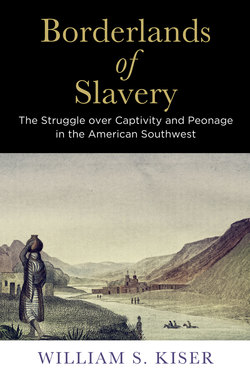Borderlands of Slavery

Реклама. ООО «ЛитРес», ИНН: 7719571260.
Оглавление
William S. Kiser. Borderlands of Slavery
Отрывок из книги
Borderlands of Slavery
Series editors Brian DeLay, Steven Hahn, Amy Dru Stanley
.....
In addition to the nomadic tribes inhabiting outlying regions, thousands of Pueblo Indians occupied permanent settlements in the more central portions of New Mexico and they too might protect black slaves. As with the lower and middle classes of the Hispano population, many Pueblos sympathized with the enslaved and entertained “none of the prejudices against the color of the negro,” meaning that they would likely abet their escape whenever possible.63 Any compassionate disposition toward slaves on the part of New Mexico’s people emanated at least in part from the ongoing captive trade. Having been so frequently exposed to the horrors of human bondage, it stood to reason that many Indians and lower-class Hispanics would be sensitive to the plight of escaped black slaves. In their general ambivalence to race, New Mexicans represented the polar opposite of most easterners, whose prejudices drove them to abhor not just African Americans, but also the Indians and mixed-blood mestizos of the Southwest.
Setting aside the geographical and racial arguments against human bondage, Representative Marsh invoked the popular abolitionist claim of morality, positing that only the human conscience could truly check the spread of slavery. “Slavery is everywhere profitable, under the management of a prudent master,” Marsh proclaimed, and mere geographic or climatic concerns could therefore never prevent its spread entirely. Commending the abolition of slavery in some New England states, he delivered a pious diatribe to his Southern opponents, claiming that slavery in the North “was abolished, not because it was contrary to the economical law of profit and loss, but because our fathers held it … to be contrary to the law of conscience and of God.”64 Horace Mann, a Massachusetts representative, shared this theological tenet of abolitionism; insisting that the existence of slavery was strictly a matter of conscience, he provocatively declared that “wherever the wicked passions of the human heart can go, there slavery can go.”65 Building upon this rationale, Senator Smith pronounced that the only real obstacle to chattel slavery in New Mexico “results from principles and jurisprudence acknowledged by the whole civilized world.”66 Thus, from the ideological standpoint of staunch abolitionists, the issue of slavery in newly acquired territories should be viewed as a matter of ethics and humanity rather than economics or legality.
.....